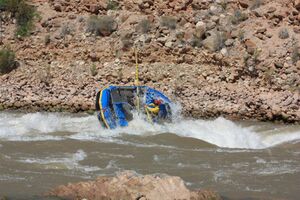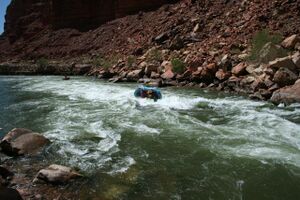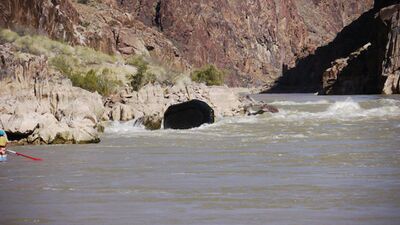If your Boat Flips…
What about if your boat flips?
 Running the hole in 209 flipped this 18-foot-long raft.
Running the hole in 209 flipped this 18-foot-long raft.
You may not experience flipping a raft on your journey, but you might. You might encounter another trip that has flipped a raft or is having some other river-related safety issue. How you and your trip respond to these situations may save a life or at the least, make someone else’s trip more enjoyable.
You will be rescued, but many rescues are self-rescues, so take responsibility for yourself and others. Some fear is normal and good; panic is unnecessary.
It will be smooth and slow or violent, but you will know you are leaving the boat. Grab a breath because you're going underwater. Shouting "Oh shit!" is optional, but traditional.
It's confusing underwater. You may experience a number of things, like the cold, bubbles, dark, equipment, noise, and swirling current. You might get smacked by the raft or gear on the raft. This is normal. You will surface shortly because you wore your PFD.
You may come up under the boat. This is OK, but you need to get out from under the boat. Put your hands over your head and hand-walk your way out from under the boat. If you cannot go one way due to current or gear, go another way. It works. This will get you out from under the overturned raft, so don't panic, but get out from under the boat. Your trip companions will be looking for you, and they need to see you to help with your rescue.
When you surface away from the boat, it will again be chaotic. This is OK. Look around NOW. See where the boats and swimmers are (including your boat) and look for a rescue rope in a throw bag. Likely you will be swimming a bit, but look just in case. Remember self-rescue.
Generally, the best position is to put your feet downstream and lay back, doing a backstroke to maneuver, fending off rocks with your feet if you are close to shore. Look around. If you are mid river, swim to the nearest boat.
 A slow flip in Twentythree Mile Rapid.
A slow flip in Twentythree Mile Rapid.
If you are in a rapid, you will not be able to breathe well at all. Your chin will be at water level and you will sink in the froth. Chop will go in your mouth with the air. You will swallow water and not get nearly enough air. This will be temporary, but it will be a surprise. You may get pushed under water several times and pop back up. You will not be able to maneuver much until the rapid's tail-waves. Relax, stay aware, and ride it out. It will end.
If there is no rescuer and you are close to your boat, swim to your boat and climb on the bottom or go to shore. On the Colorado, your boat is usually closer to you then the shore. Stay upstream of the boat if you can. Get to an end and climb the rescue line up on the boat. Do it as soon as you can. The cold water will sap your strength.
Some boatmen will rig a flip line under their boat that runs from oar lock to oar lock. Some will run the flip line from stem to stern. Some boatmen will rig slack lines, a 20 foot length of free rope, floating in the water and tied to a corner of the boat. There may be four slack lines tied to four corners of a single raft. Check with your boatman about flip lines, as not all boatmen use them.
As you float next to the overturned raft, you may need to swim around the raft a little looking for the flip line if your boat has one.
Look around for your fellow swimmers and the probable rescue boat. Help the swimmers get on the boat with you. If near enough to shore, the water is shallow enough and the water is not moving swiftly, you can walk the boat to shore. Otherwise, stay on the boat.
If there is a rescuer and you are in the water, maneuver toward them. There will be one or more ropes coming your way, or they will just grab you. It is easiest to get a rope that is behind you as you can backstroke to it. Grab the rope in the middle, not the end or the bag. Pull it tight. Roll on your back with your head toward the rescuer (you will be looking away from them) and hold the rope tight across your chest and at your waist. As they pull, a pillow of water will form behind your head and you will be able to breathe.
Don't grab the rescuers unless instructed to. The rescuers will grab you by your PFD shoulder straps and fall backward in the boat. Help them out a little by kicking your legs. Once dragged into the boat, you will both be in a pile. Get up and look for other swimmers. Help get them into the boat.
 Doing the slow roll at 232 Mile off the "Killer Fang".
Doing the slow roll at 232 Mile off the "Killer Fang".
You may also get thrown a rope while you are on the overturned boat. Take care that this rope does not pull you off the overturned raft. Get your boat close to the rescue boat, and hold on to it as the boatman strains to get you to the bank. Do not attach the two boats to each other unless instructed to do so by your boatman.
Once rescued, you may need time to regain your composure. Even seasoned river travelers may be shaken by a flip and or swim, and contemplate ending the trip. This is a normal experience. What will happen is you will calm down, realize you're rescued and feeling good in the air and hot sun. You will soon have a story to tell for the rest of the trip. Some river travelers will not have this experience, and will want to burn off the adrenaline by helping right the raft. That’s fine.
Rescuers should make sure swimmers are not too cold. Hot drinks and dry clothing help warm a cold swimmer.
Click here to return to the River Safety page.